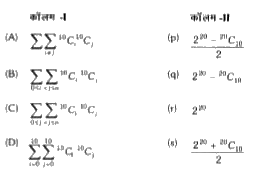यदि f(x)=ex1+ex,I1=∫f(a)f(−a)xg{x(1−x)}dx और I2=∫f(a)f(−a)g{x(1−x)}dx, तब I2I1 का मान है
1
−3
−1
2
The correct Answer is:D
Step by step video, text & image solution for यदि f(x)=(e^x)/(1+e^x),I_(1)= int_(f(-a))^(f(a)) x g{x(1-x)}dx और I_(2) = int_(f(-a))^(f(a))g{x(1-x)}dx, तब I_2/I_1 का मान है by Maths experts to help you in doubts & scoring excellent marks in Class 12 exams.
Updated on:21/07/2023Topper's Solved these Questions
- निश्चित समाकलन एवं वक्रों से घिरा क्षेत्रफल BOOK - ERRORLESS HINDICHAPTER - निश्चित समाकलन एवं वक्रों से घिरा क्षेत्रफल EXERCISE - JEE ADVANCED (More than one correct answers)
24 Videos
- निश्चित समाकलन एवं वक्रों से घिरा क्षेत्रफल BOOK - ERRORLESS HINDICHAPTER - निश्चित समाकलन एवं वक्रों से घिरा क्षेत्रफल EXERCISE - JEE ADVANCED (Reasoning type questions)
8 Videos
- निश्चित समाकलन एवं वक्रों से घिरा क्षेत्रफल BOOK - ERRORLESS HINDICHAPTER - निश्चित समाकलन एवं वक्रों से घिरा क्षेत्रफल EXERCISE - SOLVED MULTIPLE CHOICE QUESTIONS (वक्रों द्वारा परिबद्ध क्षेत्रफल )
97 Videos
- द्विपद प्रमेय तथा गणितीय आगमन BOOK - ERRORLESS HINDICHAPTER - द्विपद प्रमेय तथा गणितीय आगमन EXERCISE - JEE Advanced (Matrix Math type questions)
5 Videos
- प्रायिकताBOOK - ERRORLESS HINDICHAPTER - प्रायिकताEXERCISE - EXERCISE
99 Videos
Similar Questions
यदि In=∫π−πsinnx(1+πx)sinxdx , n = 0 , 1, 2 ..........., तब
View Solutionकथन-1 : समाकलन ∫π/3π/6dx1+√tanx का मान π/6 है
कथन-2 : ∫baf(x)dx=∫baf(a+b−x)dx
View Solutionवक्र y=xex2 , x- अक्ष तथा कोटियों x = 0, x = a से घिरा क्षेत्रफल है
View Solutionनिम्नलिखित कॉलम I को कॉलम II से मिलाये

View SolutionA, B, C तीन परस्पर स्वतंत्र घटनायें हैं। S1 तथा S2 दो कथनों को देखने पर
S1 : A तथा B∪C स्वतन्त्र हैं
S2 : A तथा B∩C स्वतन्त्र हैं तब
View SolutionIf f(x)=ex1+ex,I1=∫(f(−a))f(a)xg(a(1−x)dx,andI2=∫f(a)f(−a)g(x(1−x))dx, then the value of I2I1 is (a) −1 (b) −2 (c) 2 (d) 1
View SolutionIf I_(1)=int_(0)^(oo)f((2)/(x)+(x)/(2))(ln x)/(x)dx,I_(2)=int_(0)^(oo)f((2)/(x)+(x)/(2))(dx)/(x) and I_(3)=int_(-oo)^( oo)xf(e^(x)+e^(x))dx then
View SolutionIf f(x)=ex1+ex,I1=∫f(a)f(−a)xg(x(1−x))dx and I2=∫f(a)f(−a)g(x(1−x))dx, then I2I1= (A) −1 (B) −3 (C) 2 (D) 1
View SolutionIf f(x)=e21+ex,I1=∫f(a)f(−a)xg{x(1−x)}dx and I2=∫−f(−a)f(−a)g{x(1−x)}dx, where g is not identify function. Then the value of I2/I1, is
View Solutionयदि f(x)=ex1+ex,I1=∫f(a)f(−a)xg{x(1−x)}dx और I2=∫f(a)f(−a)g{x(1−x)}dx, तब I2I1 का मान है
View SolutionIf f(x)=(e^(x))/(1+e^(x)),I_(1)=int_(f(-a))^(f(a))xg{x(1-x)}dxandI_(2)=int_(f(-a))^(f(a))g{x(1-x)}dx, then the value of (I_(2))/(I_(1)) is
View SolutionIf f(x)=ex1+ex,I1=∫f(a)f(−a)xg{x(1−x)}dxandI2=∫f(a)f(−a)g{x(1−x)}dx, then I2I1 is :
View SolutionLet I1=∫ba(∫xaf(t)dt)dxandI2=∫ba(b−x)f(x)dx then
View SolutionIf f(x)=ex1+ex,I1=∫f(a)f(−a)xg{x(1−x)}dxandI2=∫f(a)f(−a)g{x(1−x)}dx, then the value of I2I1 is
View SolutionIf f(x) =(e^x)/(1+e^x), I_1=int_(f(-a))^(f(a)) xg(x(1-x))dx , and I_2=int_(f(-a))^(f(a)) g(x(1-x))dx, then the value of (I_2)/(I_1) is
View Solution
